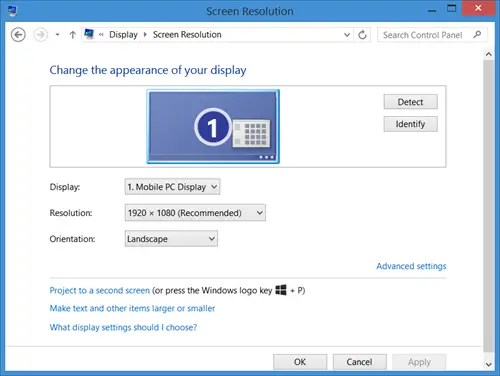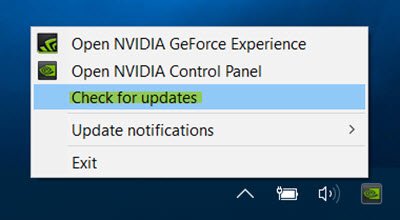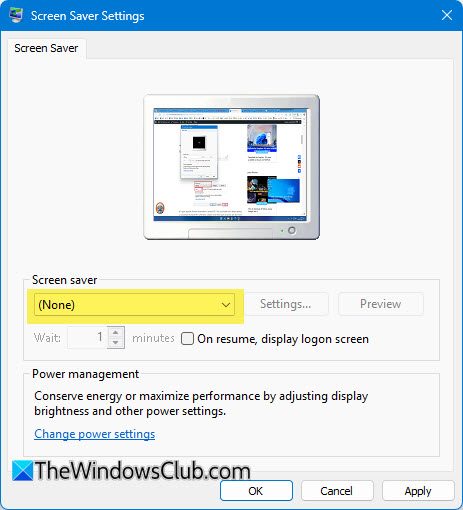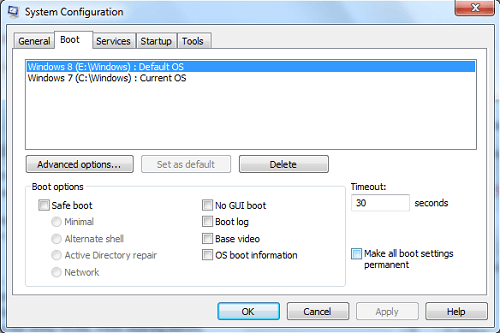Do your Display settings keep reverting in Windows 11/10? This is a common issue many Windows users report – ‘Every time I start up or log out of my Windows computer, it automatically switches the screen resolution to a different from the default one‘. The problem may occur if you have enabled Advanced Performance in the Device Manager, and now even after disabling it, the problem may persist. If this problem is by any installed software, the software should be removed to see if it helps resolve the issue.
In Windows 11/10, you typically set the screen resolution via the Control Panel, as shown in this image below.

In Windows 7, you were forced to reboot to apply all the changes to the display screen resolution. In Windows 11/10/8.1/8, you are not forced to reboot your Windows PC. But if you don’t, the display changes may not be applied to all items on the screen, like, for instance, the Start Screen. So if you are facing issues after changing the screen resolution, reboot your Windows computer and see if it makes the problem go away.
Display settings keep reverting in Windows 11/10
If you find that your screen resolution keeps changing automatically on its own, after sleep or after reboot, here are a few suggestions you can try:
- Check Graphics Drivers
- Disable screensaver
- Uncheck Base Video setting
- Check Power Settings
- Run Display Quality Troubleshooter
Screen Resolution changes after reboot automatically on its own
1] Check Graphics Drivers

Ensure that your Drivers are up-to-date. Specifically, update your Graphics Card drivers. If need be, uninstall them and fresh-install their latest downloaded version. Just because you’ve upgraded your operating system to Windows 11/10 doesn’t necessarily mean you have the most up-to-date drivers on your computer. To ensure you have the most up-to-date driver, check the driver version number and compare that with information on the developer’s Web site.
2] Disable screensaver

Disable the screensaver and see if it helps.
3] Uncheck Base Video setting
Run msconfig. Then, on the Boot Tab, ensure that the BaseVideo option is unchecked. Restart.

4] Check Power Settings
Try changing the Power Settings, to allow for Sleep Mode, when sharing media. Then, from an administrative command prompt, execute the following command:
powercfg -h on
5] Run Display Quality Troubleshooter
Try the Windows Display Quality Troubleshooter.
I hope something helps.
Display settings keep resetting on startup in Windows
If Display settings keep resetting on startup in Windows 11/10, it could be due to various reasons, such as outdated drivers, corrupted user profiles, or conflicting software. Update your graphics drivers, update monitor firmware, reset Display Settings, run Startup Repair, restore defaults in Power Plan and see if it helps.
Why do my display settings keep changing in Windows 11?
If your display settings keep changing in Windows 11/10, it could be due to Outdated or Faulty Graphics Drivers, incorrect Power Settings, Third-Party Software Conflicts, etc. Follow the suggestions laid down in this post to resolve the problem.
NOTE: MichaelAtOz posts on Answers the following. Thanks for this bevhoward:
Using Sysinternals ProcessMonitor I found that Windows was accessing the following Registry path:
HKEY_LOCAL_MACHINE\SYSTEM\CurrentControlSet\Control\GraphicsDrivers\Configuration
My system had three entries:
-
DELF003YY7707BR0MUL_30_07D7_6A^9A3774EB79DEE3E3E38496CC7DF4D936
-
QHD32000001_31_07D6_D5^63E1ABDD175E7871DCAEB710418A0F75
-
SIMULATED_8086_2A42_00000000_00020000_1010100^CDE365D1B3F0942F0CF38BFB8E127AB4
Under each is a tree called “00” two of the keys are:
- PrimSurfSize.cx
- PrimSurfSize.cy
Under “00” was another branch also called “00” two of the keys are:
- ActiveSize.cx
- ActiveSize.cy
The first two of the configs (ie DELF003YY7707BR0MUL & QHD32000001) the above keys were 1440×900 – so they were not involved.
The third (SIMULATED) was set to 1024×768.
I changed these to 1600×900 and the problem was solved.
Further, I changed the resolution (via Control Panel) to 1920×1080. The moving/resize issue returned, but the lower right corner was set to 1600×900, ie the SIMULATED… settings.
Why does my monitor settings keep resetting?
Monitor settings often reset due to outdated firmware, which can be fixed by downloading the latest updates from the manufacturer’s website. Additionally, check your monitor’s on-screen display (OSD) settings for power or display options that might revert to defaults. Adjust these settings to ensure they’re saved correctly.
How do I stop Windows from changing display settings?
Ensure your graphics drivers are current to prevent Windows from automatically changing display settings. Navigate to ‘Device Manager’, expand ‘Display adapters’, right-click your graphics card, and select ‘Update driver’. Additionally, check for malware with trusted antivirus software, as it can sometimes cause unexpected changes in system settings.
These links may also interest you:
Actually, Anand, there’s even more wisdom in the video drivers part than you might realize; than most people realize, in fact. Most people have no idea just what role the video drivers play in Windows overall performance. So significant is it that if a Windows machine is acting strangely, but you just can’t put your finger on what’s going on, simply re-install (or, better yet, first check the PC’s maker’s support site and see if there are newer one, and, of so, install those; otherwise, re-install) first the chipset drivers, and then the video drivers, rebooting before, between, and after. Suddenly the machine’s more stable, and no one really knows why. [grin] (I’m kidding… I know why.)
Seriously, though, it’s kinda’ inexplicable. It just works. A friend in engineering at HP told me that little trick years and years ago. Every time I’ve done it, something got better, even if whatever was wrong which made me do it in the first place might still be doing it. Often whatever was causing the weirdness will only be changed; and by said changing, suddenly something else becomes easier to diagnose. It’s weird.
And, yes, it stands to reason, then, the reinstalling every one of the machine’s drivers can be helpful in other ways; but there’s just something about reinstalling first the chipset drivers, and then the video drivers, that somehow seems to cure a raft of ills…
…for reasons only the computer gods seem to understand. [grin]
Go figure.
__________________________________
Gregg L. DesElms
Napa, California USA
gregg at greggdeselms dot com
Veritas nihil veretur nisi abscondi.
Veritas nimium altercando amittitur.
Thanks for sharing your experience here Gregg.
It’s actually a monitor issue.
Some monitors (especially hdmi/TV monitors don’t keep the hdmi port “alive” when they are powered down.
As a result, when windows reboots or comes out of sleep, it can’t detect a monitor, so it sets resolution to it’s “SIMULATED” monitor registry entry in the key at;
HKLMSYSTEMCurrentControlSetControlGraphicsDriversConfiguration
This can be manually edited to contain the actual screen registration of your default monitor.
There is a long and extensive discussion on this issue, including details on the above at;
http://answers.microsoft.com/en-us/windows/forum/windows_7-hardware/windows-7-movesresizes-windows-on-monitor-power/1653aafb-848b-464a-8c69-1a68fbd106aa
Hope that this information is valuable,
Beverly Howard
Thanks for the link. I am sure it will help someone some day! :)
omg thank you so much!! i’ve been looking for a solution to this for a while
Awesome! Thanks for the help!
very useful…thank you very much.
When ever I’m playing Minecraft, the screen resolution changes and cuts half of the screen off automatically, is there a way to fix this? Its getting frustrating to record YouTube videos for it because of that.
Why is it people can’t just answer the damn question or say I don’t know?
I have a problem where my NVidia based resolution says 3840×2160 (Recommended).
Great, it’s recommended but that’s NOT what I want. I leave it at 1920×1080 because anything higher is no big deal and slows the PC down. Like what the hell when your just scaling everything up to see it all anyway.
So, I have my settings and on occasion depending on the game or simply turning the TV on it changes the resolution to recommended and my Icons are screwed up.
But that’s NOT WHAT I WANT!!!!!
And there is no way to turn this feature off and no one will give a God damn answer on how to do it if you can.
Hell, I can research and all my inquiries that come up in Google are from years ago where they were asking about this crap in Windows 7 and STILL didn’t find a solution.
As if this issue is completely ignored throughout the industry.
What I want is NOT what YOU WANT or recommend.
NOW, in Windows 10 you can’t even stop the updates.
I installed an Nvidia driver and had everything I wanted it to be and Microsoft thought best it would update my driver that installed ALL the options like the 3D stuff I can’t even use.
WOW, the US Government, especially the Military is going to embrace the fact that they can’t install their own packages. Win 10 is going to be a huge seller with Microsoft’s top contracts.
I really hate this automation crap that comes out of the tech industry, stop holding my hand I’m a big boy. Maybe…Juuuuuuuuuust MAYBE I know what’s best for me and my machines than you do MicroSOFT!!!
Hi, We are a bunch of Windows enthusiasts that offer free advice. But we do not wait here 24×7 to answer questions. We have our own lives. If you have any feedback to give, giving it to Microsoft Answers may help. Here, you can ‘request’ help, and maybe someone will surely try and help you. :)
This is an argument that spans across the internet. Yahoo Answers mostly.
Instead of giving a valid answer it usually comes out to “Well WHY do you want to do that?” instead of just answering the damn question.
9×10 I end up figuring it out on my own because the average every day person is just dumber than shiz.
I ended up turning off the graphics cards ability to auto detect the TV and taadaa it doesn’t have the capability to give me what IT thinks I want.
I seriously hate some pious 2 bit programer always wanting to fix what’s not broken.
Here’s a thought….
When you first install Windows, go to the minimum standard resolution.
Then after the user changes the resolution to what they want leave it the fk alone. Stop interpreting what I want and DO what I want.
>> I ended up turning off the graphics cards ability to auto detect the TV
and taadaa it doesn’t have the capability to give me what IT thinks I
want. <<
Where was that setting? I'm guessing that your graphics card's driver included the setting, but, in my case, an HP Pavilion using it's onboard hdmi output, there is no apparent way to do the same.
So… it's back to the registry edit posted above for the new box.
Beverly Howard
Mine is happening based on PowerPoint. The new display features in PPT 2013 reset the resolution every time. I am turning it on and off frequently since I am in a classroom where sometimes I show PPT and sometimes demonstrate directly from my desktop, I have to reset it every time… help?
Every time I reboot my display settings revert to default..mainly the text size and bold, my eyes are a bit weak so I prefer bold size 9 on everything. Very frustrating to have to reset text size after a reboot. Help pls
Huge Thanks! You’re the first person I’ve run across that understands this!!!!
I have Windows 10 on a fairly new Laptop – it came with Windows 10. And the screen randomly changes sizes when I’m working on it and frankly at times makes me want to fling it against a wall. I do not want to pay $7.99 per month or nearly $100 a year to download Drivers as recommended on this page on the off chance that these will fix the problem. And why should I have 24 Drivers out of date on a six month old computer anyway? BTW, this issue has been there from day one. Even if the Drivers Updater were to solve the problem, I would feel gouged. I have made various changes in settings but nothing works. I never upgraded to “Advanced Settings” or ever, until today, messed with the computer. I am not tech savvy and, frankly, don’t see why I should be. This is a fundamental and elemental problem and likely the straw breaking the camel’s back for this PC owner. If anyone has a simple solution, I would be so grateful to hear it.
>> I do not want to pay $7.99 per month or nearly $100 a year to download… <<
You are letting the scammers scam you… always download drivers from the computer mfg's website. It's then unlikely that you will ever be charged as the driver sources located at the top of search lists do and your description of the scenario tends to suggest.
Next, set your win10 to update non windows components so that it is never necessary to download and install.
The problem you describe does not sound like a driver issue… it's more likely a hardware problem, especially if it happens when you are using the computer as your post suggests. You make no mention of the computer's make and model number which makes it impossible to give detailed help.
Beverly Howard
Hi Beverly – thank for such a quick response. The link to the drivers update site was on this page, but probably found its way there because I had not so long ago been directed to a drivers update site – probably the same one. I didn’t buy into anything, phew!
The computer is a Lenovo Flex 3.
In my case I will have to disagree on drivers, after experiencing the very annoying W10 ‘auto resolution resize’ phenomenon, I actually solved my problem by using a 6 month old driver version. Absolutely don’t care why, it works and that’s all I care about.
Alright, this is a year ago but I just wanted to say, I’m totally with you, man. There is no logical explanation why MS doesn’t adress this problem at all, since they believe – in their misguided way of believing – they made a fully responsive all platform OS with Win10… they certainly did not!
8/10!? NO
Also 7 professional!
Hello sir, I have the same problem discussed above and this only happen until I change the CPU recently. But previously, the resolution is stable. Ill try to check later and swap monitors. If the problem remains the same, then probably problem was really in drivers
Worked, thx, wish I could donate a 0.00001% of a bitcoin or something xD thx so much
I am using laptop HP 2d28tu with windows 7 for last 2 years. I had to format it two days ago. After formatting, it changes resolution every time I connect a parallel monitor to it. I thought it is because the drivers I have are older. But HP does not support this model now and no new drivers are available there. I am sure previously I had updated drivers from HP website. Can those drivers be available anywhere ?
@happyandyk:disqus Thank you so much dude! I had the BaseVideo ticked and completely forgot about it, and literally could not figure out why my monitors were resting. Tried clean installs of drivers, and display spatters and couldn’t get it sorted. Was so close to re-formatting Windows again. Thanks again!
When I close the monitor of my pc that runs windows 10, and re open the screen when I am back, the resolution changes to something close to 240×360 and nothing can be seen clearly. I have a 32″ monitor and this is a big problem.
Windows 10 need to stop altering the resolution I set it to be. Somehow the OS tries to find the resolution when it shouldn’t, I set it on a specific resolution and it should simply accept it until I change it.
stop playing minecraft
Just letting you know bev, you helped me help someone else with this. 5 years, and still doing good